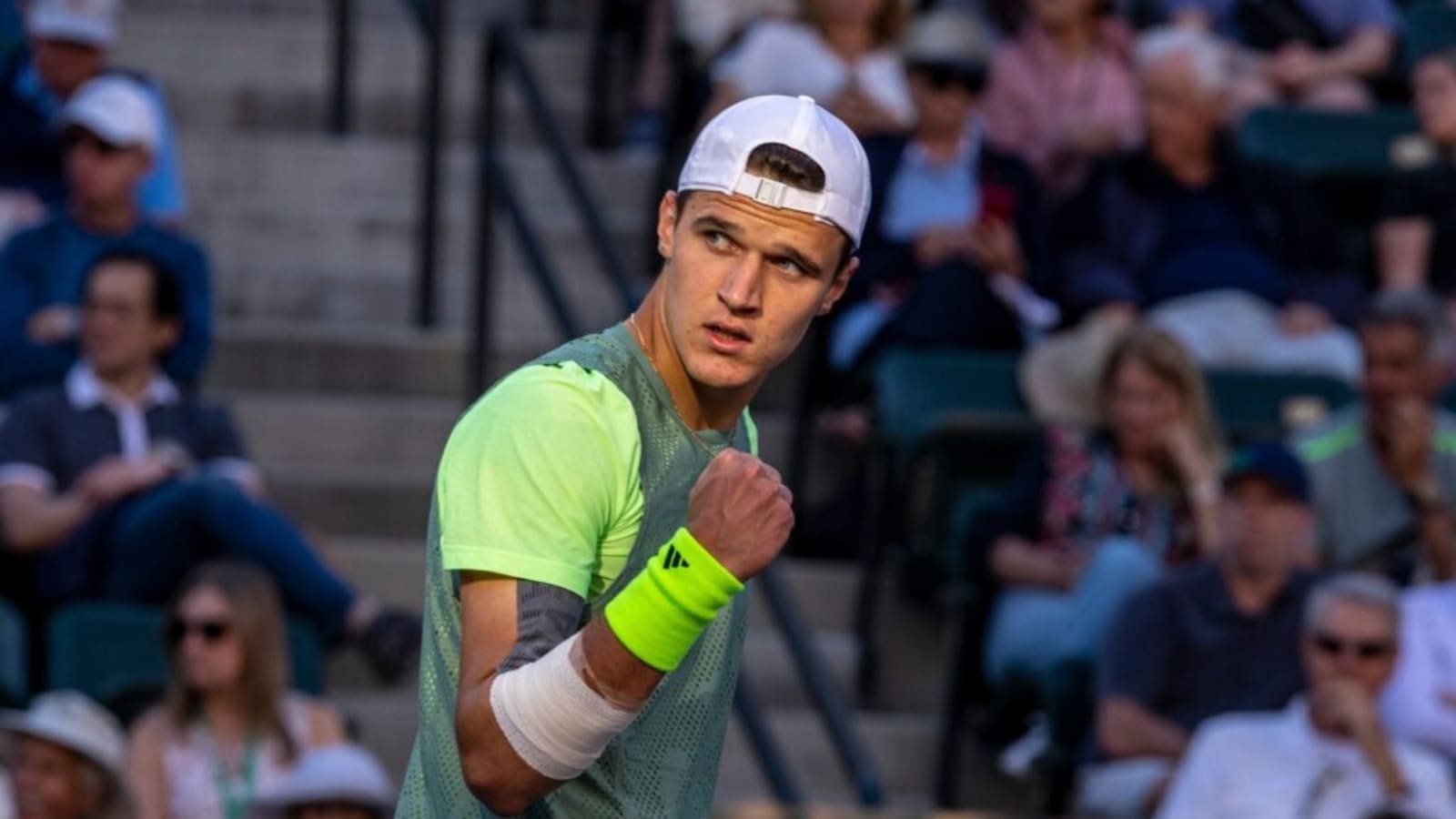
Jakub Mensik’s victory over Novak Djokovic in the Miami final was historic for many reasons: he won his first ATP Tour title and at Masters level to boot; in the process, he denied his idol Novak Djokovic his 100th ATP Tour title; and he became the second youngest ever player to win the title in Florida, after Carlos Alcaraz in 2022. Those were among the immediate “takeaways” from the tournament for the 19-year-old. However, what might be of longer-term historical importance is that he may also have announced that he is the next great Czech tennis player, the latest in a long line of champions from the central European country whose tennis success belies its relatively small population.
Is Mensik About To Become The Next Great Czech Player?
There are approximately 10 million people in Czechia (the latest name for the former Czechoslovakia and Czech Republic) and it sometimes seems as if the country has produced almost as many great tennis players. That is obviously an exaggeration, but what is not an exaggeration is that the Czechs are one of the truly great tennis-playing nations, in both the men’s and the women’s game.
In his runners-up speech after the Miami final, Novak Djokovic himself referred to the great Czech tennis tradition when he said (as quoted in The Guardian): “His serve is incredible, powerful, precise and he wins a lot of free points with the first serve. Backhand, as well. Czech school – they always have a great backhand.”
There may be no one “Czech school” of tennis per se, but Djokovic was alluding to the near-century-old tradition of the Czechs producing a disproportionately high number of technically excellent tennis players. That excellence is perhaps best embodied in the consistently high number of Czech players who have been equipped with a very strong backhand, which of course is probably the most unnatural and therefore hardest-to-teach shot in tennis. And yet Mensik, like so many Czech players before him, has a superb backhand, which was one of the keys to his victory over his childhood idol in the Miami final.
A Very Brief History of Czech Tennis
The great Czech tennis tradition, or at least the great list of Czech (or former Czech) men and women who have won Majors, began with Jaroslav Drobný, who was probably one of the most skilful and certainly one of the most storied players in the history of the sport. Indeed, his own personal history is almost the history of his homeland in the 20th century, as he found himself being driven into exile twice, first by the Nazi invasion of Czechoslovakia and then by the subsequent Communist takeover of the country after World War Two.
Consequently, Drobny ended up representing at least four different countries, with his greatest–i.e. Major-winning–achievements coming as an Egyptian citizen, after Egypt offered him citizenship when he was officially stateless after fleeing Communist control. It was as an Egyptian that he won three Major Singles titles (two French Opens in 1951 and 1952, and Wimbledon in 1954). However, despite his obvious debt of gratitude to his new home country, there was never any doubt that his real tennis education had come as a child and young man in Czechoslovakia.
Drobny was far from being the only great Czech tennis player to be driven into exile in the second half of the 20th century. In fact, the two players who are probably the finest Czech female player ever and the finest Czech male player ever respectively–Martina Navratilova and Ivan Lendl–both defected to the United States and eventually became U.S. citizens during the 1970s and early 1980s.
At least until recently and what increasingly appears to be the new order, the Czech Republic and now Czechia have enjoyed much greater political stability, which has meant that its best young tennis players no longer have to flee their birthplace to reach the top of the sport. Indeed, ever since the fall of the Berlin Wall in 1989, there have been no fewer than five different Czech Major-winners, beginning with Petr Korda and Jana Novotná in 1998 (at the Australian Open and Wimbledon respectively) and extending right through to Barbora Krejčíková at Wimbledon last year.
Four of those five different Major-winners have been female, with arguably the finest Czech female player since Navratilova, Karolina Muchova, reaching the final of the 2023 French Open and enjoying one of the all-time great runs at a Major at last year’s US Open. That incredible individual female success has also translated into near dominance of the Fed Cup (the original name for the BJK Cup), with the Czech Republic winning an astonishing six Fed Cups in the eight seasons between 2011 and 2018.
Now, however, it seems that the very best young Czech players emerging are men, with Mensik just one of a trio of truly talented young Czech men–the other two being Jiri Lehecka and Tomáš Macháč–who will surely become the major challengers to Italy’s recent dominance in the Davis Cup.
Mensik The Heir To A Tradition–And The Embodiment of a New Trend
Nevertheless, notwithstanding the obvious merits of both Lehecka and Macháč, it does seem that the much younger Mensik (he is still a teenager, whereas Lehecka is 22 and Macháč 23) is the cream of the current Czech crop. Indeed, he has already evidenced that with his incredible run to the final in Miami and even more so with his defeat of Djokovic in the final.
Djokovic, who is statistically at least the GOAT of men’s tennis, is also a keen student of tennis history. That was why he was able to refer so easily and effortlessly to the “Czech school” of tennis that Mensik is the latest graduate of. However, he may also have identified a much newer trend in tennis, which Mensik is also the embodiment of.
In his very gracious runner’s-up speech in Miami, Djokovic also said of Mensik: “I’m super-glad he’s using the potential he has, because he’s got the complete game.” Mensik does indeed have “the complete game”: the huge first serve that is now almost obligatory for a top player; excellence on both forehand and backhand wings; and astonishing mobility, especially, “for a tall, big guy like that,” as Djokovic put it. Djokovic neglected to add that Mensik is also comfortable at the net and capable of astonishing touch and invention, but that is surely implied by the comment that he has “the complete game.”
Mensik is just the latest of the very young male players, after Jannik Sinner, Carlos Alcaraz and to a certain extent João Fonseca, to have emerged at an incredibly young age with “the complete game”, i.e. a game with no apparent weaknesses. In that respect, they are all the true heirs of The Big Three–Roger Federer, Rafael Nadal and Novak Djokovic–who all became “complete” players by the end of their careers.
What is really fascinating is that Mensik, Sinner, Alcaraz and Fonseca are arguably far more “complete” players at their very young ages than any of The Big Three were at a comparable point in their career. Astonishing as it seems now, all three of The Big Three had major weaknesses in their game at the start of their careers that they only fixed later on: Federer’s backhand was a relative weakness until the remodelling of it at the end of his career that enabled the last and arguably greatest stage of that career; Nadal was initially only really comfortable on clay; and Djokovic struggled with physical conditioning and illness until the diagnosis of his gluten intolerance in 2010.
The best young male players who have emerged in the post-Big Three era are already so staggeringly “complete” as players that the mind boggles as to what they may be capable of later in their career. And Jakub Mensik’s name can now definitely be added to that list. He is both the heir apparent to the great Czech tradition of technical excellence in tennis and the embodiment of the much newer–indeed, almost brand-new–tradition of complete players emerging almost immediately in the wake of The Big Three.
More must-reads:
- Clemson HC Dabo Swinney fumes over college football officiating, calls for 'accountability'
- Kevin Durant, Draymond Green argue over Warriors' titles, and they're both right
- The 'World Series MVPs' quiz
Breaking News
Trending News
Customize Your Newsletter
 +
+
Get the latest news and rumors, customized to your favorite sports and teams. Emailed daily. Always free!








